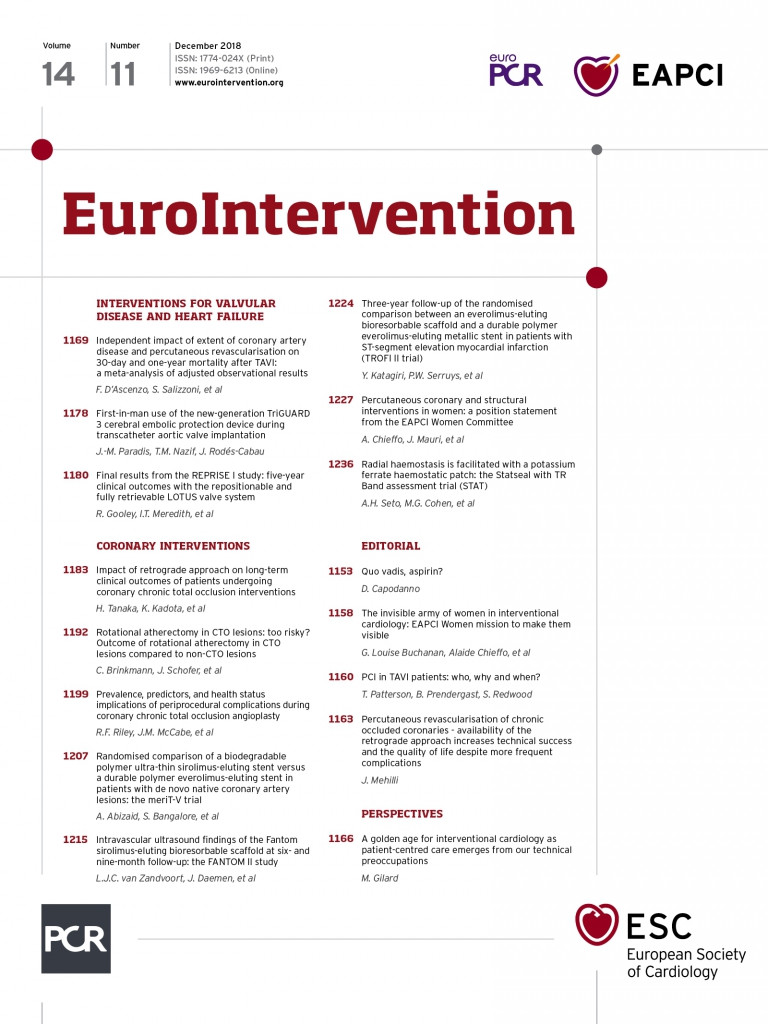
Since the first percutaneous coronary intervention (PCI), performed by Andreas Roland Grüntzig on 9 May 1977, the number of coronary angioplasties has been constantly increasing. PCI has revolutionised the management of coronary heart disease and millions of people around the world have benefited. Several explanations can be given for this: the rapid progress in balloon, catheter and stent technologies, optimisation of stent implantation techniques, and the development of effective antithrombotic therapy following intervention.
The field of this minimally invasive approach for the treatment of coronary artery disease has undergone impressive technological advances. New-generation drug-eluting stents are based on novel metal alloys, allowing thinner stent struts, and releasing novel drugs with improved antirestenotic properties. Clinical efficacy, assessed as freedom from in-stent restenosis and subsequent need for repeat revascularisation, and clinical safety, assessed as freedom from coronary ischaemic events, have dramatically improved in recent years. This has allowed PCI to be applied to higher-risk patients and lesions.
Widespread adoption of angioplasty and stenting was crucially dependent on the development of effective antithrombotic therapy following intervention. Nevertheless, the inherent thrombogenicity of metal stents in contact with circulating blood resulted in thrombotic stent occlusion despite aggressive anticoagulation therapy. In 1991, Patrick Serruys, reporting on angiographic follow-up after self-expanding coronary artery stenting, showed early occlusions in approximately 20% of cases1, associated with haemorrhagic and peripheral vascular complications due to the intensive anticoagulation therapy. In 1994, Paul Barragan was the first to suggest that ticlopidine could be effective in this setting2. The optimal intensity and duration of dual antiplatelet therapy has been the object of considerable controversy over the last decade in particular, with an ESC consensus statement published in 20173.
After more than 40 years, our profession has matured. We have reached the limits of coronary angiography, notably thanks to intracoronary imaging which has revealed the different types of atherosclerotic plaque in vivo. This has, in turn, led to a major contribution in our understanding of the importance of stent expansion and apposition, resulting in lower rates of stent thrombosis. This has been of particular importance in left main PCI for determining correct diameters and the usefulness of the proximal optimisation technique in bifurcations. Although application is not – and cannot be – systematic, the lessons learned have been very important. Understanding these limitations has facilitated the development of physiological exploration of these angiographic stenoses.
Some of us are still seeking to push back the boundaries of angioplasty, with the advent of the treatment of chronic total occlusions. This technique, which has become largely standardised and simplified, has made the treatment of the majority of coronary stenoses much more straightforward. Currently, isolated treatment of coronary stenosis by stenting is no longer an end in itself. The “oculostenotic reflex” is on the way to being cured.
In recent years, a large number of registries and randomised trials have tried to assess the benefit of PCI versus surgery, PCI versus medical treatment, specific devices or the best antithrombotic treatment.
Over the years, accumulated data have demonstrated that, in the case of acute coronary syndromes, early PCI increases survival and decreases the rate of recurrent myocardial infarction. In contrast, in patients with stable coronary artery disease, there was a long-standing controversy concerning the role and timing of PCI in order to improve clinical outcome and provide symptomatic relief. At EuroPCR 2018, strong evidence was presented, for the first time, of the efficacy of PCI in stable patients when the procedure is guided by a physiological approach. The Norwegian SCAAR registry has, for the first time, demonstrated a reduction in mortality in these stable patients, with genuine long-term (10-year) follow-up. Also, FAME-2, with five years of follow-up4, confirmed that the classic primary endpoints – a composite of death from all causes, myocardial infarction and urgent revascularisation – show FFR-guided PCI plus medical therapy to be more effective than medical therapy alone in patients with stable coronary artery disease. Moreover, at five years, 51.0% of patients originally assigned to medical therapy alone had in fact undergone revascularisation – PCI in these stable patients improved symptoms and quality of life.
It is true that we have progressed. We have assimilated the technical intricacies of our profession and gone beyond them, to the patient’s benefit. In our teaching, consideration of the patient as a whole must now become paramount, including not only history and symptoms, but also lifestyle and wishes. The therapeutic decision, which must imperatively be adapted to the individual patient as well as to the competence of each centre, is a focus of the new European guidelines, as well as treatment modalities – PCI, surgery or medical therapy. This maturity is very clear and has been applied in the new percutaneous treatments, including the emblematic TAVI introduced by Alain Cribier. Developments in this technique were framed by studies, which investigated outcomes and, very quickly, spectacular results were obtained by modifying devices, refining patient selection and adapting the means of implantation. No technique other than TAVI has ever been so thoroughly studied. Yet here again, the need to improve symptomatology and to respect the patient’s wishes, as made clear in the latest ESC guidelines5, is particularly important.
Interventional cardiology has a very rich and positive history, thanks to its many pioneers, but we need to remember that Rome was not built in a day. Over the years since its inception, we have seen the whole community adopting these innovative approaches, developing percutaneous treatments in which efficacy can be measured, not just in terms of an absolute criterion such as post-procedural mortality, but also by improvement in survival and quality of life. The future can indeed be radiant if we focus our discipline and our studies on the patient as the living centre of all our efforts.
Conflict of interest statement
The author has no conflicts of interest to declare.

